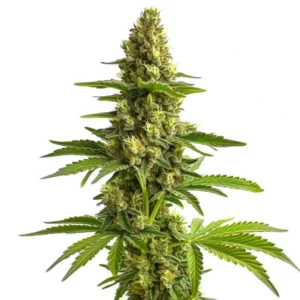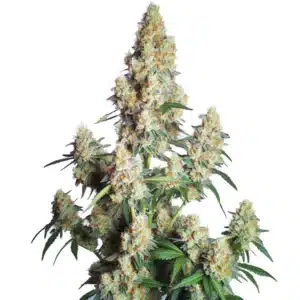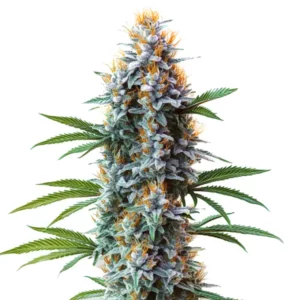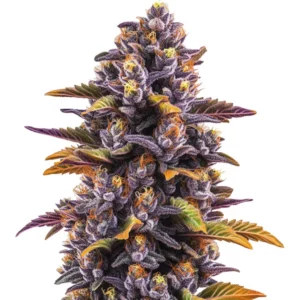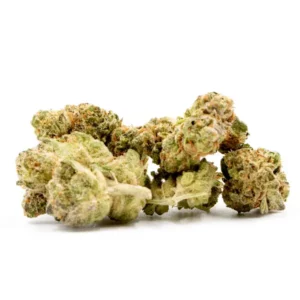
What is Transpiration in Cannabis Plants?
Transpiration in cannabis plants is a process similar to how we sweat. It’s when water travels from the roots to the leaves, exiting through small openings called stomata. This movement of water helps the plant stay cool and transport nutrients.
Think of transpiration as the plant’s cooling system and nutrient highway. It plays a crucial role in keeping cannabis plants healthy by balancing water levels and delivering essential minerals. Without it, plants would overheat and become nutrient-deficient.
Recommended Strains
Bruce Banner #3
|
|
THC | 20% - 29% (High) |
|
|
Type | Feminized |
|
|
Yield | Medium |
|
|
Phenotype | 50% Indica / 50% Sativa |
GG4
|
|
THC | 27% (High) |
|
|
Type | Feminized |
|
|
Yield | High |
|
|
Phenotype | 40% Indica / 60% Sativa |
For those growing cannabis for the first time, understanding how transpiration works can be a game-changer. Knowing the process helps you manage water efficiently and ensure optimal plant growth. Even experienced growers find value in refining their knowledge of transpiration in cannabis plants.
How Does Transpiration Affect Cannabis Plant Growth?
Transpiration affects cannabis plant growth in several ways. It regulates temperature and maintains internal water balance, ensuring that plants don’t wilt or suffer heat stress. This process also aids in nutrient uptake, vital for robust plant development.
When water evaporates from the leaves, a suction force pulls more water and nutrients up from the roots. This continuous cycle supports photosynthesis, the process by which plants convert light into energy. Essentially, without effective transpiration, growth would be stunted.
Moreover, understanding how does transpiration affect cannabis plant growth allows growers to fine-tune their care regimes. By monitoring and adjusting environmental elements such as light and temperature, growers can optimize plant health. This understanding is especially crucial in controlled environments like greenhouses, where precise adjustments can lead to improved yields.
Furthermore, the role of stomata in cannabis transpiration process is intertwined with growth. Stomata must function efficiently to ensure water and gas exchange occur at optimal levels. Any disruptions in the opening and closing of stomata can lead to imbalances, affecting the overall growth and vitality of the plant.
Promos & Deals
Role of Stomata in Cannabis Transpiration Process
Stomata are tiny pores on the leaf surface, acting as the plant’s gatekeepers. They open and close to regulate water loss and gas exchange, playing a direct role in the transpiration process. When stomata open, water vapor exits, allowing the plant to “breathe.”
The role of stomata in cannabis transpiration is crucial. They adjust based on environmental conditions, such as light and humidity. For instance, in high humidity, stomata may remain closed longer to conserve water.
Knowing the function of stomata in cannabis transpiration process is essential for managing water use. Stomata’s ability to open and close in response to environmental signals means growers can influence transpiration by controlling these variables. This control can lead to healthier plants and more efficient water usage.
Additionally, the health and functionality of stomata directly impact how does transpiration affect cannabis plant growth. If stomata are not operating correctly, the plant’s ability to cool itself and uptake nutrients can be compromised, leading to potential growth issues and reduced yields.

Factors Influencing Transpiration Rate in Cannabis Plants
Several factors influence the transpiration rate in cannabis plants. These include temperature, humidity, light intensity, and wind. Each factor can either increase or decrease how much water a plant uses.
Temperature plays a significant role; higher temperatures generally increase transpiration. Likewise, bright light boosts the process as plants open their stomata wider to maximize photosynthesis. Conversely, high humidity slows down transpiration because the air is already saturated with moisture.
Knowing the factors influencing transpiration rate in cannabis plants can help growers create more effective growing environments. For instance, adjusting light schedules or using fans to control temperature can optimize transpiration rates, leading to healthier plants.
Additionally, consideration of these factors can prevent common issues like nutrient lockout or dehydration. By managing elements such as humidity and temperature, growers can ensure that their cannabis plants receive the right balance of water and nutrients, enhancing growth and quality.
Importance of Transpiration for Cannabis Plant Health
The importance of transpiration for cannabis plant health cannot be overstated. It facilitates nutrient transport, crucial for plant growth and development. Without it, plants would struggle to access essential nutrients, affecting yield and quality.
Transpiration also helps manage internal temperature, preventing heat stress. By releasing water vapor, plants can cool themselves, much like how humans cool down by sweating. This process is essential for maintaining overall plant health.
Recognizing the importance of transpiration for cannabis plant health is key to successful cultivation. Growers who can maintain a balanced transpiration rate will see improvements in plant resilience, leading to fewer issues with pests and diseases.
Furthermore, consistent transpiration supports optimal photosynthesis, ensuring that plants efficiently convert light into energy. This efficiency is crucial for maximizing growth potential and achieving high-quality yields.
Impact of Humidity on Transpiration in Cannabis Plants
Humidity has a significant impact on transpiration in cannabis plants. High humidity levels can slow down the process because the leaf surfaces become saturated, reducing the need for the plant to release more water.
Conversely, low humidity increases transpiration rates. This can lead to faster water loss, potentially causing the plant to dehydrate if not managed properly. For growers, monitoring humidity is crucial to maintain balanced transpiration.
The impact of humidity on transpiration in cannabis plants can also influence nutrient uptake. High humidity might impede the plant’s ability to draw nutrients from the soil, whereas low humidity can lead to over-transpiration and nutrient deficiencies.
By knowing and managing the impact of humidity on transpiration in cannabis plants, growers can tailor their environmental controls. Using tools like humidifiers or dehumidifiers can help maintain the desired humidity levels, ensuring healthy plant growth and optimal transpiration.
Recommended Cannabis Strains from Blimburn Seeds
- Bruce Banner #3: Known for its resilience, this strain thrives in various environments and is ideal for beginners learning about transpiration.
- Gorilla Glue #4: Offers a robust growth pattern, making it a great choice for understanding how environmental factors influence transpiration.
- Blue Dream: A classic strain that balances well under different humidity levels, perfect for growers focused on optimizing transpiration.

FAQs
How does transpiration affect cannabis plant growth?
Transpiration is crucial for cannabis plant growth as it regulates water and nutrient uptake. It ensures that plants have the necessary resources to develop strong stems and lush foliage. Without adequate transpiration, plants would struggle to grow healthily.
Additionally, this process helps maintain the plant’s internal temperature, preventing heat stress. By understanding and optimizing transpiration, growers can significantly enhance their cannabis yield and quality.
Knowing how does transpiration affect cannabis plant growth also highlights the importance of environmental management. By optimizing factors such as light and temperature, growers can enhance transpiration efficiency, leading to better growth outcomes.
Moreover, a deeper understanding of transpiration can guide growers in selecting the right strains and cultivation techniques, further improving plant health and yield potential.
What is the role of stomata in cannabis transpiration?
Stomata are microscopic openings on the undersides of leaves, essential for the transpiration process. They control the exchange of gases, including water vapor, by opening and closing based on environmental conditions.
The stomata’s ability to regulate water loss is vital for maintaining plant health. By ensuring proper functioning, growers can better manage the plant’s water use and overall health.
The function of stomata in cannabis transpiration process is pivotal for plant survival. Efficient stomatal function ensures that plants maintain the necessary balance between water retention and gas exchange, crucial for photosynthesis and growth.
Growers can influence the role of stomata in cannabis transpiration by manipulating environmental factors such as humidity and light. This control can lead to improved water use efficiency and healthier plants.
What factors influence the transpiration rate in cannabis plants?
The transpiration rate in cannabis plants is influenced by several environmental factors such as temperature, light intensity, humidity, and air movement. Each of these factors can either speed up or slow down the rate of water loss.
Growers can manipulate these conditions to ensure plants transpire optimally. By doing so, they can improve nutrient uptake and overall plant health, leading to better yields.
Recognizing the factors influencing transpiration rate in cannabis plants allows growers to create environments that promote healthy growth. By adjusting these factors, growers can maintain optimal transpiration and nutrient uptake.
Furthermore, understanding these factors helps in diagnosing potential issues related to water and nutrient imbalances, allowing for more effective cultivation strategies and improved plant resilience.
Why is transpiration important for cannabis plant health?
Transpiration is vital for cannabis plant health as it aids in nutrient distribution and temperature regulation. It ensures that plants receive adequate nutrients for growth and development while preventing overheating.
Healthy transpiration rates contribute to the plant’s ability to resist pests and diseases. For growers, managing transpiration is a key factor in cultivating a successful cannabis crop.
The importance of transpiration for cannabis plant health extends to maintaining the plant’s overall vitality. By ensuring proper water and nutrient flow, transpiration supports robust growth and higher resistance to environmental stressors.
Effective management of transpiration can lead to improved plant performance and higher yields, making it a critical aspect of cannabis cultivation that growers should prioritize.
How does humidity impact transpiration in cannabis plants?
Humidity significantly impacts transpiration rates. High humidity can decrease transpiration as the air is saturated with moisture, reducing the plant’s need to release water. This can lead to issues like nutrient lockout if not careful.
On the other hand, low humidity increases water loss, which can dehydrate plants. Growers must carefully monitor and adjust humidity levels to maintain balanced transpiration and ensure healthy plant growth.
The impact of humidity on transpiration in cannabis plants is a crucial consideration for growers aiming to optimize plant health. By managing humidity levels, growers can prevent water-related stress and ensure efficient nutrient uptake.
Using tools such as hygrometers and environmental controls, growers can maintain the ideal humidity conditions for their plants, facilitating optimal transpiration and improving overall plant quality.


